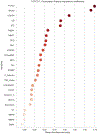Multiple Plasma Biomarkers for Risk Stratification in Patients With Heart Failure and Preserved Ejection Fraction
- PMID: 32192654
- PMCID: PMC7147356
- DOI: 10.1016/j.jacc.2019.12.069
Multiple Plasma Biomarkers for Risk Stratification in Patients With Heart Failure and Preserved Ejection Fraction
Abstract
Background: Better risk stratification strategies are needed to enhance clinical care and trial design in heart failure with preserved ejection fraction (HFpEF).
Objectives: The purpose of this study was to assess the value of a targeted plasma multi-marker approach to enhance our phenotypic characterization and risk prediction in HFpEF.
Methods: In this study, the authors measured 49 plasma biomarkers from TOPCAT (Treatment of Preserved Cardiac Function Heart Failure With an Aldosterone Antagonist) trial participants (n = 379) using a Multiplex assay. The relationship between biomarkers and the risk of all-cause death or heart failure-related hospital admission (DHFA) was assessed. A tree-based pipeline optimizer platform was used to generate a multimarker predictive model for DHFA. We validated the model in an independent cohort of HFpEF patients enrolled in the PHFS (Penn Heart Failure Study) (n = 156).
Results: Two large, tightly related dominant biomarker clusters were found, which included biomarkers of fibrosis/tissue remodeling, inflammation, renal injury/dysfunction, and liver fibrosis. Other clusters were composed of neurohormonal regulators of mineral metabolism, intermediary metabolism, and biomarkers of myocardial injury. Multiple biomarkers predicted incident DHFA, including 2 biomarkers related to mineral metabolism/calcification (fibroblast growth factor-23 and OPG [osteoprotegerin]), 3 inflammatory biomarkers (tumor necrosis factor-alpha, sTNFRI [soluble tumor necrosis factor-receptor I], and interleukin-6), YKL-40 (related to liver injury and inflammation), 2 biomarkers related to intermediary metabolism and adipocyte biology (fatty acid binding protein-4 and growth differentiation factor-15), angiopoietin-2 (related to angiogenesis), matrix metalloproteinase-7 (related to extracellular matrix turnover), ST-2, and N-terminal pro-B-type natriuretic peptide. A machine-learning-derived model using a combination of biomarkers was strongly predictive of the risk of DHFA (standardized hazard ratio: 2.85; 95% confidence interval: 2.03 to 4.02; p < 0.0001) and markedly improved the risk prediction when added to the MAGGIC (Meta-Analysis Global Group in Chronic Heart Failure Risk Score) risk score. In an independent cohort (PHFS), the model strongly predicted the risk of DHFA (standardized hazard ratio: 2.74; 95% confidence interval: 1.93 to 3.90; p < 0.0001), which was also independent of the MAGGIC risk score.
Conclusions: Various novel circulating biomarkers in key pathophysiological domains are predictive of outcomes in HFpEF, and a multimarker approach coupled with machine-learning represents a promising strategy for enhancing risk stratification in HFpEF.
Keywords: HFpEF; Penn Heart Failure Study; TOPCAT trial; biomarkers; fibrosis; inflammation; kidney; liver.
Copyright © 2020 American College of Cardiology Foundation. Published by Elsevier Inc. All rights reserved.
Figures







Comment in
-
A Biomarker Approach to Understanding HFpEF.J Am Coll Cardiol. 2020 Mar 24;75(11):1296-1298. doi: 10.1016/j.jacc.2020.01.020. J Am Coll Cardiol. 2020. PMID: 32192655 Free PMC article. No abstract available.
References
-
- Desai AS, Lewis EF, Li R et al. Rationale and design of the treatment of preserved cardiac function heart failure with an aldosterone antagonist trial: a randomized, controlled study of spironolactone in patients with symptomatic heart failure and preserved ejection fraction. Am Heart J 2011;162:966–972 e10. - PubMed
-
- Pfeffer MA, Claggett B, Assmann SF et al. Regional variation in patients and outcomes in the Treatment of Preserved Cardiac Function Heart Failure With an Aldosterone Antagonist (TOPCAT) trial. Circulation 2015;131:34–42. - PubMed
-
- Pitt B, Pfeffer MA, Assmann SF et al. Spironolactone for heart failure with preserved ejection fraction. N Engl J Med 2014;370:1383–92. - PubMed
-
- Lam CSP, Gamble GD, Ling LH et al. Mortality associated with heart failure with preserved vs. reduced ejection fraction in a prospective international multi-ethnic cohort study. Eur Heart J 2018;39:1770–1780. - PubMed
Publication types
MeSH terms
Substances
Grants and funding
LinkOut - more resources
Full Text Sources
Other Literature Sources
Medical
Research Materials

